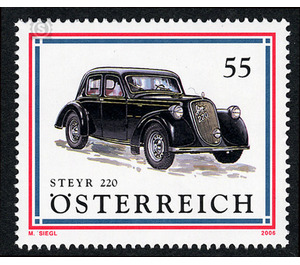automobile - Austria / II. Republic of Austria 2006 - 55 Euro Cent
Theme: Traffic, Transportation & Mobility
| Country | Austria / II. Republic of Austria |
| Issue Date | 2006 |
| Face Value | 55.00 |
| Edition Issued | 500,000 |
| Printing Type | Photogravure |
| Stamp Type | Commemorative |
| Item Type | Stamp |
| Chronological Issue Number | 1950 |
| Chronological Chapter | OOS-OE2 |
| SID | 780642 |
| In 59 Wishlists | |
After the First World War, the Austrian factory in Steyr, which was founded in 1864 as a weapons factory by Josef and Franz Werndl and now belongs to the Magna Group, was banned by the peace treaty of Versailles weapons production. In order to save the factory, the company relocated to automobile production. The conversion to civilian products succeeded, as early as 1920 rolled the first Steyr car from the factory. In 1935, the merger with the Graz Daimler Puchwerken to Steyr-Daimler-Puch AG. In Graz, the two-wheeled production remained, in Steyr cars and trucks were made. From 1936 Steyr brought the small car of the type 50 and type 55, also called "Steyr Baby", on the market, he was already considered a comfortable and robust car with good road holding. Although Steyr vehicles were technically demanding, they were unfortunately expensive due to the low number of units despite modern production methods. Nevertheless, there was enough demand for an exclusive car with more power. In Steyr, for example, Steyr 100 and Steyr 200 were developed into a prestigious vehicle and from 1937 onwards, the Steyr 220 steering wheel sedan was produced. It was the flagship of Steyr's car production, combining sophisticated technology, style and comfort. Equipped with a six-cylinder suspension valve engine with a capacity of 55 hp from a displacement of 2260 cc, the sedan reached a top speed of 125 km / h and consumed 11-15 l of fuel per 100 km with a total weight of about 1260 kg. The low center of gravity of the car together with the Steyr oscillating axle drive, independent wheel suspension and bumpless single wheel steering guaranteed an excellent roadholding. Another characteristic of the four to five-seater sedan, the all-steel body in streamlined shape and the two closing doors to each side of the wagon to mention. The factory offered the four-door sedan and a two-door convertible (with two side windows). The car series Steyr 220 was manufactured far into the war year 1941, a total of 5900 pieces. To own a Steyr 220 meant to be proud of him and to be envied. Steyr automobiles were known for their high quality and high-quality workmanship through their sporting successes and material-demanding expedition rides - Max Reisch drove over 42,000 km around the world in 1935 with a "100 Steyr".


